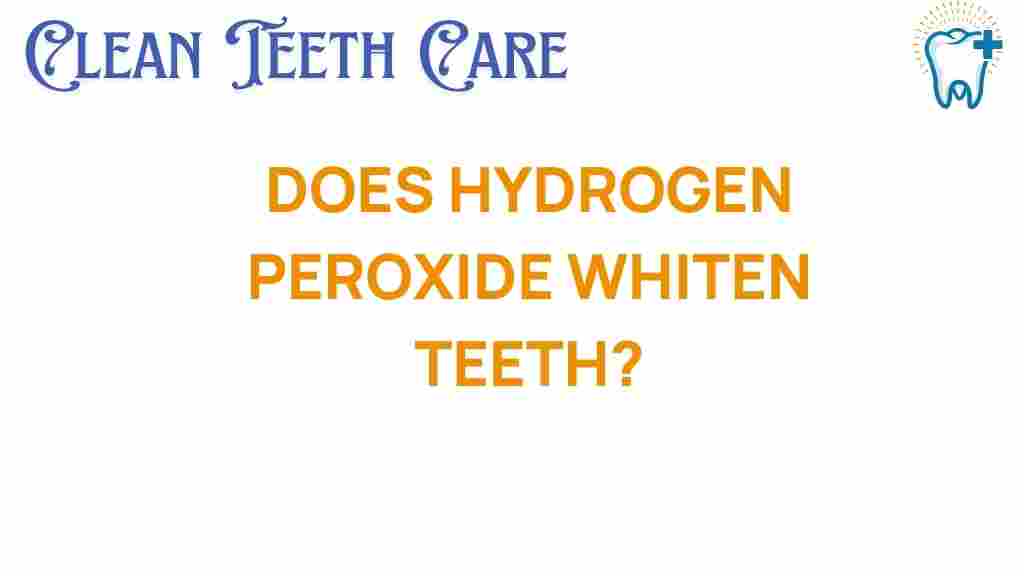The Surprising Truth: Does Hydrogen Peroxide Really Whiten Teeth?
When it comes to achieving a brighter smile, many people are searching for effective and safe teeth whitening solutions. One popular option that often comes up in discussions about teeth whitening is hydrogen peroxide. This common household product is known for its disinfectant properties and is often suggested as a home remedy for enhancing your smile. But does hydrogen peroxide truly deliver on its promise of whitening teeth? In this article, we’ll explore the truth about hydrogen peroxide, its benefits, safety, and best practices for use in oral health and dental care.
Understanding Hydrogen Peroxide
Hydrogen peroxide (H2O2) is a colorless liquid that is widely used for various purposes, including cleaning, disinfecting, and as a bleaching agent. Its oxidizing properties allow it to break down stains and discoloration on teeth, making it a common ingredient in many commercial teeth whitening products.
The Science Behind Teeth Whitening
Teeth can become discolored for several reasons, including:
- Food and drink stains (coffee, tea, red wine)
- Tobacco use
- Age-related discoloration
- Poor dental hygiene
Hydrogen peroxide works by penetrating the enamel and breaking down the compounds that cause these stains. This process can lead to a visibly whiter smile, which is why many people are curious about using it at home.
Using Hydrogen Peroxide for Teeth Whitening
For those interested in trying hydrogen peroxide for smile enhancement, here are some practical steps to follow:
Step 1: Choose the Right Concentration
When using hydrogen peroxide for teeth whitening, it is crucial to select the appropriate concentration. Commonly, a 3% solution is recommended for home use. Higher concentrations can lead to increased sensitivity and potential damage to the enamel.
Step 2: Prepare Your Solution
You can use hydrogen peroxide in several ways:
- As a mouth rinse: Mix equal parts of hydrogen peroxide and water to create a mouthwash. Swish it around your mouth for about 30 seconds and then spit it out.
- As a whitening paste: Combine hydrogen peroxide with baking soda to form a paste. Apply this mixture to your toothbrush and brush gently for 1-2 minutes.
- In toothpaste: Some people add a few drops of hydrogen peroxide to their regular toothpaste before brushing.
Step 3: Frequency of Use
To achieve optimal results while maintaining oral health, it is advisable to use hydrogen peroxide treatments sparingly. A frequency of 1-2 times per week is typically recommended, as overuse can lead to enamel erosion and increased tooth sensitivity.
Step 4: Rinse and Care
After using hydrogen peroxide, rinse your mouth thoroughly with water to remove any residue. It’s also essential to wait at least 30 minutes before consuming any food or beverages to allow your teeth to recover and minimize sensitivity.
Safety Considerations for Hydrogen Peroxide Use
While hydrogen peroxide can be an effective home remedy for teeth whitening, safety should always be a priority. Here are some important considerations:
- Consult with a dentist: Before starting any whitening regimen, it’s a good idea to speak with your dentist, especially if you have sensitive teeth or existing dental issues.
- Avoid swallowing: Hydrogen peroxide is not safe to ingest; ensure that you spit it out after use.
- Monitor for sensitivity: If you experience significant discomfort or sensitivity, discontinue use and consult your dentist.
Troubleshooting Common Issues
Even with the best intentions, some individuals may encounter challenges when using hydrogen peroxide for teeth whitening. Here are some common issues and solutions:
Problem 1: Tooth Sensitivity
If you experience increased sensitivity after using hydrogen peroxide, consider the following:
- Reduce the frequency of use.
- Try a lower concentration of hydrogen peroxide.
- Use desensitizing toothpaste before and after treatments.
Problem 2: Uneven Whitening
Uneven whitening can occur if the hydrogen peroxide is not applied evenly. To avoid this:
- Ensure that the solution is well mixed and evenly distributed.
- Consider using a custom tray for more consistent application.
Problem 3: Gum Irritation
If you notice irritation of the gums, take these steps:
- Apply hydrogen peroxide carefully, avoiding direct contact with gums.
- Rinse your mouth thoroughly after application.
Alternative Whitening Methods
If hydrogen peroxide doesn’t work for you or if you prefer to explore other options, there are several alternatives for safe whitening:
- Whitening toothpaste: These products contain mild abrasives and are designed to remove surface stains.
- Whitening strips: Over-the-counter strips that contain peroxide can provide effective results with minimal effort.
- Professional treatments: Dentists offer various options, including in-office bleaching and custom take-home kits.
Conclusion
Hydrogen peroxide can indeed be a valuable tool in your dental care arsenal for achieving a brighter smile. Its effectiveness in breaking down stains makes it a popular choice for teeth whitening. However, it’s essential to use it correctly and safely to avoid potential risks, such as tooth sensitivity and gum irritation.
Remember, while home remedies like hydrogen peroxide can yield positive results, they should complement a comprehensive oral health routine that includes regular dental check-ups and good hygiene practices. If you’re considering using hydrogen peroxide for whitening, consult with your dentist to ensure it’s the right option for your smile.
For more beauty tips and insights into maintaining your oral health, explore our other articles on dental care here. For scientific studies on the effectiveness of hydrogen peroxide, check out the research conducted by the American Dental Association here.
This article is in the category Treatments and created by CleanTeethCare Team
